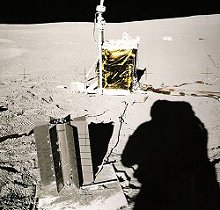Eitan Kerin, Hamda'a

The Moon is the closest celestial body to the Earth, and the only one other than the Earth that humans have visited. But despite the sacrifice, the experience of being on the moon is radically different from our day-to-day experience here on earth.
The astronauts of the "Apollo" space program in the late 60s and early 70s are the only ones who can tell what it's like to be on the moon. But many of their stories have been forgotten over the years. Now that it's about going back to the moon again, maybe it's worth going back and remembering them.

The lander casts a black shadow as the sun shines in a pitch-black sky
And the astronauts did describe a different and strange world. The first difference that comes to mind is that the gravity on the moon is only about one-sixth that on Earth, so in all the movies about the Apollo program, the astronauts are seen easily jumping to heights impossible on Earth.
There is, of course, another important difference: the moon has no atmosphere, meaning there is no oxygen to breathe and no atmospheric pressure - without space suits the astronauts would die immediately from suffocation, from the explosion of visibility and the boiling of the blood in the arteries. But the lack of atmosphere has additional and interesting effects, not all of which are understood above.
First - the sky. We are used to a blue sky during the day, when the sun crosses it from east to west, and a black, starry sky at night. On the moon, on the other hand, even during the day (which, by the way, is about two weeks long...) the sky is blacker than black and full of stars, even though the sun also shines with a brilliant and almost blinding light.
But if we face the opposite direction to the sun and look at our shadow, a surprise awaits us. If you do this experiment here, on Earth you will be able to easily distinguish the objects that lie in your shadow: grass, the edge of the sidewalk, your toes, there is enough light even in the shadows. But on the moon the story is different - the shadow is black and it is very difficult to see what is in it, the astronauts likened it to the feeling as if a piece of night is stuck to your feet and follows you - sounds quite scary.
The explanation for both phenomena lies in the atmosphere - the air molecules scatter the sunlight. They scatter the blue light more than other colors and therefore the sky during the day looks blue. This scattered light is so intense that we cannot see the starlight. Without an atmosphere the sky is black. The atmosphere scatters the light in all directions, so some of it shines in our shadow areas and allows us to see the details. Indeed, if you look at the shadow on a white surface it looks blue. There is no diffused light on the moon, so there is nothing to illuminate the shadow.
In conclusion, if you stand on the moon at midday, the picture will be like this: above you, the sky is blacker than any black you know, and yet the sun shines with a blinding light, your shadow is very dark, and the surroundings shine in a blinding white - indeed an extraterrestrial experience.
This caused difficulties for the astronauts in setting up experiments and working on the surface of the moon. Neil Armstrong, the first man on the moon, was also the first to report the shadow problem as he descended the ladder of the Apollo 11 lander: "It's pretty dark here in the shadow [of the lander] and it's a little hard for me to see if I'm putting my feet in the right place on the ladder," he said. In the radio connection to the earth.

Astronaut's shadow on the moon: The halo around his head is probably caused by the microscopic structure of the moon's surface.
In another incident, during the Apollo 14 visit, astronaut Al Shepard tried to loosen some stuck screws but unfortunately they were buried in a shady slough. And so his friend Ed Mitchell says: "Don't look at the scandals and try to see what's in them. He couldn't get the screwdriver in and loosen the screws, he just couldn't see them. You have to remember, there is no air on the moon to reflect light - so if there is no direct sunlight there is no way, in hell, to see anything. The shadow is black as pitch, it is an amazing phenomenon."
But, after a while the eyes also adjust to the shadow of the moon because some light still comes in, some of it is reflected from the surrounding hills and some is reflected from the other prominent celestial object in the moon's sky - the Earth. Just as here on Earth we can see details even in the dark in the moonlight (which is actually sunlight reflected from the Moon), so also on the Moon we can see "in the light of the Earth" even in the shadow of darkness.
But the astronauts warn: "You shouldn't go too quickly from light to shade, because the adaptation time is very long." For the information of all those preparing to visit the moon soon.
For the full article, and other phenomena related to the lunar shadow, such as the aura around the shadow of the astronaut's head seen in the bottom photo of the three
Ydan "Back to the Moon"
Hamada website
https://www.hayadan.org.il/BuildaGate4/general2/data_card.php?Cat=~~~381352455~~~15&SiteName=hayadan
